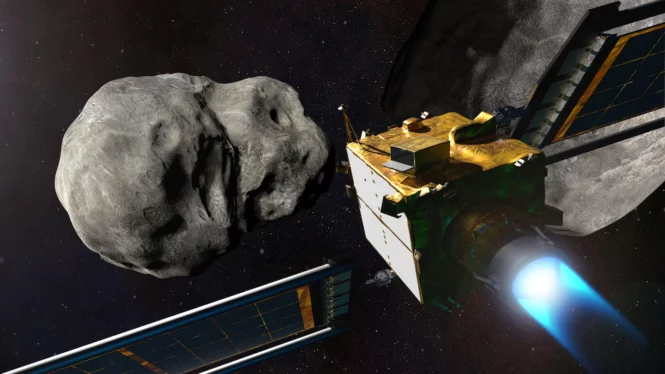
The asteroid, Dimorphos, is the scale of a stadium — or the Nice Pyramid of Giza, as one scientist put it Monday — and is about 7 million miles from Earth in the intervening time. It orbits a bigger asteroid named Didymos. Neither poses a risk to our planet now or anytime within the foreseeable future.
This was only a take a look at, NASA’s first demonstration of a possible planetary protection method, known as a kinetic impactor. The thought is to present a hypothetically harmful asteroid simply sufficient of a blow to change its orbital trajectory.
Launched final November from California, the spacecraft was small, roughly the scale of a merchandising machine or golf cart. Dimorphos is quite huge — roughly 500 toes or so in diameter, though its exact form and composition have been unknown earlier than the ultimate strategy. Scientists anticipated a plume of particles from the asteroid upon affect however no important structural change. That is extra akin to a bug splattering on a windshield.
“This isn’t simply bowling-ball physics,” Utilized Physics Laboratory planetary scientist Nancy Chabot instructed reporters. “The spacecraft’s gonna lose.”
However even small results on an asteroid’s motion might show a planet-saver. An early collision with an asteroid, if carried out early sufficient — say, 5 to 10 years prematurely of its projected encounter with Earth — could possibly be simply sufficient to sluggish it down and make it miss.
There are literally thousands of probably hazardous asteroids that come near, or cross, the Earth’s orbital path across the solar. None is at the moment recognized to be on a trajectory to hit the planet.
As engineers conceived of an asteroid deflection mission, they seized on an ingenious thought that might tremendously cut back the prices: Hit an asteroid “moonlet” that’s orbiting a bigger asteroid.
To detect the impact of a collision with a single asteroid orbiting the solar would have required two spacecraft, engineer Andrew Cheng instructed reporters, as a result of such an asteroid is shifting at large pace, and the affect from a small spacecraft would lead to a minimal, hard-to-detect change. A second spacecraft must be current to scrutinize the impact.
However a moonlet, like Dimorphos, orbits its bigger twin at a stately tempo. The impact of the affect needs to be extra simply detected — together with by telescopes on Earth and in area. No second spacecraft is critical.
It’ll take no less than a few days to inform if the DART mission succeeded in slowing down the focused asteroid, and to what diploma it did so. Telescopes on Earth and in area noticed the collision, as did a small instrument, known as a cubesat, that was deployed 15 days earlier than affect.
That is an uncommon mission in that it doesn’t contain a spacecraft making an attempt to outlive a hazardous touchdown on an alien world or proving itself operational within the tough atmosphere of outer area, famous Robert Braun, head of the area exploration sector on the Utilized Physics Laboratory.
“Right here, what we’re in search of is lack of sign,” he instructed reporters earlier than the collision. “What we’re cheering for is a lack of the spacecraft.”
By Monday afternoon the engineers in Laurel had despatched their last course corrections to the DART spacecraft, and from that time it was by itself, making last navigational changes autonomously. The automobile was aimed straight on the bigger, brighter asteroid, however programmed to fireplace thrusters that might pivot it towards the smaller asteroid when it got here into view.
Some weird situations couldn’t be dominated out as a result of the asteroid’s form wouldn’t be decided till the ultimate hour earlier than affect. Certainly, solely the bigger asteroid — not Dimorphos — could possibly be seen within the dwell feed from the spacecraft’s digital camera 90 minutes earlier than affect.
“If we have been proper heading in the right direction, and it was formed like a doughnut, we’d fly proper by it,” Braun mentioned.
Not till the ultimate minutes of DART’s journey did the spacecraft or its human operators again on Earth get a superb have a look at Dimorphos. It wasn’t seen in any respect till about an hour earlier than affect. Even then, it was only a tiny, barely perceptible dot subsequent to its brighter twin.
There was pleasure within the Mission Operations Middle because the asteroid loomed bigger on the display screen. About 50 minutes earlier than affect, venture supervisor Edward Reynolds started uttering the identical phrase: “That is nominal, that is nominal” — aerospace engineering jargon for “all the things going precisely as deliberate,” he mentioned later.
“We’ve locked on Dimorphos,” engineer Elena Adams reported 27 minutes earlier than affect.
The digital camera onboard saved snapping away. The dot grew right into a clearly spherical rock with a tough, boulder-covered floor, trying like one thing you’d preserve within the storage as a scouring instrument. Within the Mission Operations Middle, the engineers stood and cheered by the ultimate moments, too excited to sit down at their consoles.
Within the final picture, Dimorphos utterly crammed the body. DART was hitting the bull’s eye.
Then got here a clean display screen. DART had succeeded, and ceased to exist.
“Influence confirmed for the world’s first planetary protection take a look at mission,” NASA’s live-streamed broadcast introduced.
On the NASA feed, the company’s administrator, Invoice Nelson, declared that the mission had demonstrated expertise “to save lots of our planet.” Ralph Semmel, director of the Utilized Physics Laboratory, mentioned he felt an adrenaline rush as DART made a direct hit on the goal: “By no means earlier than have I been so excited to see a sign go away.”
